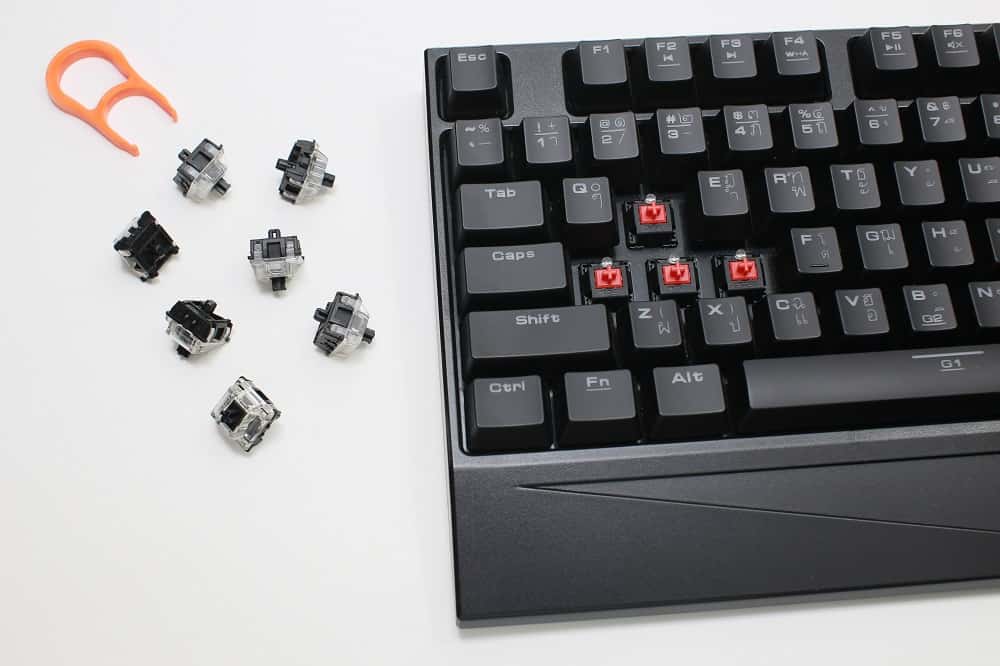While you might consider a keyboard as an afterthought when purchasing your PC, in the end, it might prove as crucial as all other accessories. As one of the primary input devices you interact with when using your computer, your choice between optical switches and mechanical switches will influence your experiences immensely.
What is an Optical Switch?
Harley E. Kelchner introduced optical switch technology in 1961. He used the technology in typewriters to reduce the noise generated by actuating the keys.
Optical switches use a light-emitter and a photosensor to detect actuated keys. Both the light emitter and sensor are housed inside the individual keys. The light emitter produces a beam of light that the light sensor detects. Depending on the working mechanisms, detection of actuated keys happens when the sensor detects the light beam or when the sensor detects an absence of light, i.e., the beam of light has been blocked.
In some cases, keyboards use a vertical and horizontal beam of light to detect key actuation. While all optical switch keyboards use an optical sensor to detect and log keystrokes, the implementation of the optical sensor technology varies.
Below are the four different types of optical keyboard switches and how they work:
1. Light Strike Keyboard Switches
As the name suggests, light strike keyboard switches utilize a mechanism that relies on light striking the sensor. To this end, in their normal state, the light transmitter emits light. However, the stem constantly blocks the light, which prevents the keystroking logging. Once pressed, the downstroke action of the stem allows light to pass through and hit the sensor, which logs a keystroke.
2. Light Block Keyboard Switches
While the light block keywords switch mechanism is rare in the mass market, some keyboards use this mechanism. With light block switches, the working mechanism of the light-emitting and sensing are flipped compared to how light strike switches work. In its idle state, the light strikes the receiver sensor. When you press the keys, the stem moves down and blocks light from reaching the sensor. The sensor, therefore, logs a keystroke.
3. Analog Optical Keyboard Switches
The technology behind analog optical keyboard switches is relatively new. As such, there are fewer keyboards that use this technology. One such keyboard is the Razer Huntsman V2 Analog.
The mechanism behind analog optical keyboards is geared towards gaming as it accords users with much more granular control of the keystrokes. Analog optical switches allow users to vary the extent of action by varying the depth of the keystroke. The analog optical switches work by varying the brightness of the IR light the sensor receives. The deeper you press a key, the brighter the lights. Conversely, a light strike results in the sensor receiving a fainter light.
4. Aimpad Optical Keyboard Switches
Aimpad switches are based on linear mechanical keyboard switches. The technology works by installing an infrared emitting LED at the bottom of the switch. Pressing the switch brightens the light reflected from the base of the switch stem, actuating the keystroke. A custom firmware controls the actuation of the switches. MasterKeys MK851 is one of the keyboards that electively use this optical switch technology.
What is a Mechanical Switch?

Mechanical switches are one of the oldest keyboard switch technology we have in use even today. Nonetheless, they are still one of the best switch technology, boasting of exceptional accuracy, durability, and customizability. Among the first keyboards to use mechanical switches was the Alps SCB1A163 in the 70s at UCLA. These Alps keyboards used mechanical reed switches. The reed switches had magnets in every key to connect 2 metallic contacts installed in a hermetically sealed tube.
In the late 1970s, Cherry key switches emerged. Cherry switches technology were prominently used in the UDS Comtest CEX-17C. In 1981, IBM released the Model F, the first mass market keyboard to use a buckling spring mechanism. In 1984, the Cherry MX black, which used linear switch technology, was introduced to the market.
Mechanical keyboards utilize a mechanical switch under the keycap. Under the removable keycap is a stem. The length of the stem determines the actuation distance and force. The vast majority of mechanical switches use bulking springs to support the mechanical action.
Rather than compressing downwards, as was the case in the past, buckling springs buckle outwards. This mechanism gives users a precise feel and better tactile feedback when using the keyboard. At the bottom of the stem is a metal contact that completes the circuit when the stem bottoms out.
Since the 1990s, the mechanical keyboard has evolved into three distinct types:
- Linear
- Tactile
- Clicky
Linear key switches travel up and down the stem without any impediment. Owing to their better actuation speed, linear switches are the most popular keyboards among gamers. Tactile switches, on the other hand, have a bump in the middle of the stem. The bump also lines up with the metal contact point. As such, keystrokes do not need to travel to the bottom to actuate keystrokes, which offers a better experience for faster typing.
Finally, clicky switches bear a similar design to tactile switches, except that they have a louder click. The more audible clicks offer typists additional feedback.
Differences Between Optical and Mechanical Switches
In trying to determine the best of the two switch options, we will compare their performances around feel, noise, speed, price, and more.
Overall Feel
For many, the consistency and certainty of the mechanical keystroke is a winner. Mechanical switches have a massive following due to the years of iteration and perfection that have improved user experience. Additionally, with ample model options, consumers will find it easier to buy a keyboard that meets their needs.
However, for some consumers, the smoother feel of optical switches offers a far better experience.
Noise Output
As mentioned above, the noise output of mechanical keyboards depends on the type of switch you choose. Individuals using the linear switches will appreciate the low noise output of this keyboard design. And if you need an ultra-quiet keyboard, there is a vast array of rubber-dampened switches that further reduce impact noise. On the other hand, clicky switches will be much noticeable.
As for optical switches, they are generally noisy. Unfortunately, the design of the stem tends to produce a hollow sound, which can be annoying to some users.
Speed
There is no clear-cut winner between mechanical and optical switches when it comes to speed. While many optical switches are faster, there are premium switches that are equally fast or faster than optical switches. It all depends on the individual model you choose and their actuation force.
Ease of Modification
Whether you want to lubricate the switches or install switch film, you will freely find the necessary information and guides on the internet. There is a huge supporting community around mechanical switches compared to optical switches.
Durability
The light operates sensors tend to be more durable compared to the electrical contact plates. As such, the vast majority of optical switches have a 100 million keystroke life span. On the other hand, mechanical switches last anywhere between 50 and 100 million keystrokes.
Budget mechanical keyboards will use inferior materials and have inferior durability of about 50 million keystrokes. Conversely, premium mechanical switches made of high-quality materials with superior engineering can last upwards of 100 million keystrokes.
Price
Due to the ubiquity of mechanical switches, there is an ample supply of generic keyboards that cater to the budget segment. There are plenty of cheap mechanical keyboards on the market. On the other hand, there is a fewer variety of optical switches on the market. Hence their prices tend to be higher.
That being said, you should note that you get what you pay for. Even the super low-cost mechanical keyboards might not meet all your needs regarding speed and tactile feedback.
Conclusion
In many regards, all optical and mechanical switches have advantages and disadvantages. With this in mind, you ought to choose a type of keyboard that best meets your needs, keeping in mind the performance metrics of the various switches.

